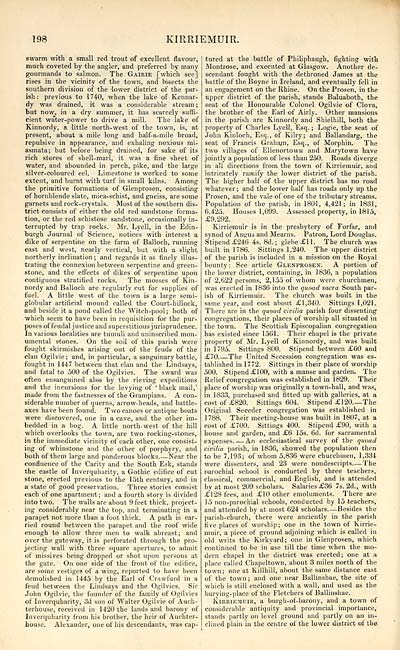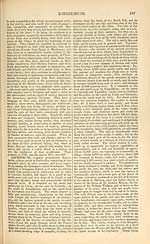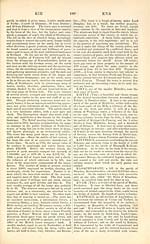Topographical, statistical, and historical gazetteer of Scotland > Volume 2
(210) Page 198
Download files
Complete book:
Individual page:
Thumbnail gallery: Grid view | List view

198
KIRRIEMUIR.
swarm with a small red trout of excellent flavour,
much coveted by the angler, and preferred by many
gourmands to salmon. The Gairie [which see]
rises in the vicinity of the town, and bisects the
southern division of* the lower district of the par-
ish : previous to 1740, when the lake of Kennar-
dy was drained, it was a considerable stream ;
but now, in a dry summer, it has scarcely suffi-
cient water-power to drive a mill. The lake of
Kinnordy, a little north-west of the town, is, at
present, about a mile long and half-a-mile broad,
repulsive in appearance, and exhaling noxious mi-
asmata; but before being drained, for sake of its
rich stores of shell-marl, it was a fine sheet of
water, and abounded in perch, pike, and the large
silver-coloured eel. Limestone is worked to some
extent, and burnt with turf in small kilns. Among
the primitive formations of Glenprosen, consisting
of hornblende slate, mica-schist, and gneiss, are some
garnets and rock-crystals. Most of the southern dis-
trict consists of either the old red sandstone forma-
tion, or the red schistose sandstone, occasionally in-
terrupted by trap rocks. Mr. Lyell, in the Edin-
burgh Journal of Science, notices with interest a
dike of serpentine on the farm of Balloch, running
east and west, nearly vertical, but with a slight
northerly inclination; and regards it as finely illus-
trating the connexion between serpentine and green-
stone, and the effects of dikes of serpentine upon
contiguous stratified rock«. The mosses of Kin-
nordy and Balloch are regularly cut for supplies of
fuel. A little west of the town is a large semi-
globular artificial mound called the Court-hillock,
and beside it a pond called the Witch-pool; both of
which seem to have been in requisition for the pur-
poses of feudal justice and superstitiousjurisprudence.
In various localities are tumuli and uninseribed mon-
umental stones. On the soil of this parish were
fought skirmishes arising out of the feuds of the
clan Ogilvie ; and, in particular, a sanguinary battle,
fought in 1447 between that clan and the Lindsays,
and fatal to 500 of the Ogilvies. The sward was
often ensanguined also by the rieving expeditions
and the incursions for the levying of 'black mail,'
made from the fastnesses of the Grampians. A con-
siderable number of querns, arrow-heads, and battle-
axes have been found. Two canoes or antique boats
were discovered, one in a cave, and the other im-
bedded in a bog. A little north-west of the hill
which overlooks the town, are two roeking-stones,
in the immediate vicinity of each other, one consist-
ing of whinstone and the other of porphyry, and
both of them large and ponderous blocks Near the
confluence of the Carity and the South Esk, stands
the eastle of Inverquharity, a Gothic edifice of cut
stone, erected previous to the 15th century, and in
a state of good preservation. Three stories consist
each of one apartment; and a fourth story is divided
into two. The walls are about 9 feet thick, project-
ing considerably near the top, and terminating in a
parapet not more than a foot thick. A path is car-
ried round between the parapet and the roof wide
enough to allow three men to walk abreast; and
over the gateway, it is perforated through the pro-
jecting wall with three square apertures, to admit
of missives being dropped or shot upon persons at
the gate. On one side of the front of the edifice,
are some vestiges of a wing, reported to have been
demolished in 1445 by the Earl of Crawfurd in a
feud between the Lindsays and the Ogilvies. Sir
John Ogilvie, the founder of the family of Ogilvies
of Inverquharity, 3d son of Walter Ogilvie of Auch-
terhouse, received in 1420 the lands and barony of
Inverquharity from his brother, the heir of Auchter-
house. Alexander, one of his descendants, was cap-
tured at the battle of Philiphaugh, fighting with
Montrose, and executed at Glasgow. Another de-
scendant fought with the dethroned James at the
battle of the Boyne in Ireland, and eventually fell in
an engagement on the Rhine. On the Prosen, in the
upper district of the parish, stands Baluaboth, the
seat of the Honourable Colonel Ogilvie of Clova,
the brother of the Earl of Airly. Other mansions
in the parish are Kinnordy and ShielhilL both the
property of Charles Lyell, Esq. ; Logie, the seat of
John Kinloch, Esq., ©f Kilry ; and Ballandarg, the
seat of Francis Graham, Esq., of Morphin. The
two villages of Ellenortown and Marytown have
jointly a population of less than 250. Roads diverge
in all directions from the town of Kirriemuir, and
intricately ramify the lower district of the parish.
The higher half of the upper district has no road
whatever; and the lower half has roads only up the
Prosen, and the vale of one of the tributary streams.
Population of the parish, in 1801, 4,421; in 1831,
6.425. Houses 1,099. Assessed property, in 1815,
£9,292.
Kirriemuir is in the presbytery of Forfar, and
synod of Angus and Mearns. Patron, Lord Douglas.
Stipend £246 4s. 8d. ; glebe £1 1. The church was
built in 1786. Sittings 1,240. The upper district
of the parish is included in a mission on the Royal
bounty : See article Glenprosen. A portion of
the lower district, containing, in 1836, a population
of 2,622 persons, 2,155 of whom were ehurchmen,
was erected in 1836 into the quoad sacra South par-
ish of Kirriemuir. The church was built in the
same year, and cost about £1,340. Sittings 1,021.
There are in the quoad civilia parish four dissenting
congregations, their places of worship all situated in
the town. The Scottish Episcopalian congregation
has existed since 1561. Their ehapel is the private
property of Mr. Lyell of Kinnordy, and was built
in 1795. Sittings 800. Stipend between £60 and
£70. — The United Secession congregation was es-
tablished in 1772. Sittings in their place of worship
500. Stipend £100, with a manse and garden. The
Relief congregation was established in 1829. Their
place of worship was originally a town-hall, and was,
in 1833, purchased and fitted up with galleries, at a
cost of £820. Sittings 604. Stipend £120 The
Original Seceder congregation was established in
1788. Their meeting-house was built in 1S07, at a
cost of £700. Sittings 400. Stipend £90, with a
house and garden, and £6 15s. 6d. for sacramental
expenses. — An ecclesiastical survey of the quoad
civilia parish, in 1836, showed the population then
to be 7,193; of whom 5,836 were churchmen, 1,334
were dissenters, and 23 were nondescripts — The
narochial school is conducted by three teachers,
classical^ commercial, and English, and is attended
by at most 209 scholars. Salaries £36 7s. 2d., with
£128 fees, and £10 other emoluments. There are
15 non-parochial schools, conducted by 15 teachers,
and attended by at most 624 scholars — Besides the
parish-church, there were anciently in the parish
five places of worship; one in the town of Kirrie-
muir, a piece of ground adjoining which is called in
old writs the Kirkyard; one in Glenprosen, which
continued to be in use till the time when the mo-
dern chapel in the district was erected; one at a
place called Chapeltown, about 3 miles north of the
town; one at Killhill, about the same distance east
of the town; and one near Ballinshae, the site of
which is still enclosed with a wall, and used as the
burying-place of the Fletchers of Ballinshae.
Kirriemuir, a burgh-of-barony, and a town of
considerable antiquity and provincial importance,
stands partly on level ground and partly on an in-
clined plain in the centre of the lower district of the
KIRRIEMUIR.
swarm with a small red trout of excellent flavour,
much coveted by the angler, and preferred by many
gourmands to salmon. The Gairie [which see]
rises in the vicinity of the town, and bisects the
southern division of* the lower district of the par-
ish : previous to 1740, when the lake of Kennar-
dy was drained, it was a considerable stream ;
but now, in a dry summer, it has scarcely suffi-
cient water-power to drive a mill. The lake of
Kinnordy, a little north-west of the town, is, at
present, about a mile long and half-a-mile broad,
repulsive in appearance, and exhaling noxious mi-
asmata; but before being drained, for sake of its
rich stores of shell-marl, it was a fine sheet of
water, and abounded in perch, pike, and the large
silver-coloured eel. Limestone is worked to some
extent, and burnt with turf in small kilns. Among
the primitive formations of Glenprosen, consisting
of hornblende slate, mica-schist, and gneiss, are some
garnets and rock-crystals. Most of the southern dis-
trict consists of either the old red sandstone forma-
tion, or the red schistose sandstone, occasionally in-
terrupted by trap rocks. Mr. Lyell, in the Edin-
burgh Journal of Science, notices with interest a
dike of serpentine on the farm of Balloch, running
east and west, nearly vertical, but with a slight
northerly inclination; and regards it as finely illus-
trating the connexion between serpentine and green-
stone, and the effects of dikes of serpentine upon
contiguous stratified rock«. The mosses of Kin-
nordy and Balloch are regularly cut for supplies of
fuel. A little west of the town is a large semi-
globular artificial mound called the Court-hillock,
and beside it a pond called the Witch-pool; both of
which seem to have been in requisition for the pur-
poses of feudal justice and superstitiousjurisprudence.
In various localities are tumuli and uninseribed mon-
umental stones. On the soil of this parish were
fought skirmishes arising out of the feuds of the
clan Ogilvie ; and, in particular, a sanguinary battle,
fought in 1447 between that clan and the Lindsays,
and fatal to 500 of the Ogilvies. The sward was
often ensanguined also by the rieving expeditions
and the incursions for the levying of 'black mail,'
made from the fastnesses of the Grampians. A con-
siderable number of querns, arrow-heads, and battle-
axes have been found. Two canoes or antique boats
were discovered, one in a cave, and the other im-
bedded in a bog. A little north-west of the hill
which overlooks the town, are two roeking-stones,
in the immediate vicinity of each other, one consist-
ing of whinstone and the other of porphyry, and
both of them large and ponderous blocks Near the
confluence of the Carity and the South Esk, stands
the eastle of Inverquharity, a Gothic edifice of cut
stone, erected previous to the 15th century, and in
a state of good preservation. Three stories consist
each of one apartment; and a fourth story is divided
into two. The walls are about 9 feet thick, project-
ing considerably near the top, and terminating in a
parapet not more than a foot thick. A path is car-
ried round between the parapet and the roof wide
enough to allow three men to walk abreast; and
over the gateway, it is perforated through the pro-
jecting wall with three square apertures, to admit
of missives being dropped or shot upon persons at
the gate. On one side of the front of the edifice,
are some vestiges of a wing, reported to have been
demolished in 1445 by the Earl of Crawfurd in a
feud between the Lindsays and the Ogilvies. Sir
John Ogilvie, the founder of the family of Ogilvies
of Inverquharity, 3d son of Walter Ogilvie of Auch-
terhouse, received in 1420 the lands and barony of
Inverquharity from his brother, the heir of Auchter-
house. Alexander, one of his descendants, was cap-
tured at the battle of Philiphaugh, fighting with
Montrose, and executed at Glasgow. Another de-
scendant fought with the dethroned James at the
battle of the Boyne in Ireland, and eventually fell in
an engagement on the Rhine. On the Prosen, in the
upper district of the parish, stands Baluaboth, the
seat of the Honourable Colonel Ogilvie of Clova,
the brother of the Earl of Airly. Other mansions
in the parish are Kinnordy and ShielhilL both the
property of Charles Lyell, Esq. ; Logie, the seat of
John Kinloch, Esq., ©f Kilry ; and Ballandarg, the
seat of Francis Graham, Esq., of Morphin. The
two villages of Ellenortown and Marytown have
jointly a population of less than 250. Roads diverge
in all directions from the town of Kirriemuir, and
intricately ramify the lower district of the parish.
The higher half of the upper district has no road
whatever; and the lower half has roads only up the
Prosen, and the vale of one of the tributary streams.
Population of the parish, in 1801, 4,421; in 1831,
6.425. Houses 1,099. Assessed property, in 1815,
£9,292.
Kirriemuir is in the presbytery of Forfar, and
synod of Angus and Mearns. Patron, Lord Douglas.
Stipend £246 4s. 8d. ; glebe £1 1. The church was
built in 1786. Sittings 1,240. The upper district
of the parish is included in a mission on the Royal
bounty : See article Glenprosen. A portion of
the lower district, containing, in 1836, a population
of 2,622 persons, 2,155 of whom were ehurchmen,
was erected in 1836 into the quoad sacra South par-
ish of Kirriemuir. The church was built in the
same year, and cost about £1,340. Sittings 1,021.
There are in the quoad civilia parish four dissenting
congregations, their places of worship all situated in
the town. The Scottish Episcopalian congregation
has existed since 1561. Their ehapel is the private
property of Mr. Lyell of Kinnordy, and was built
in 1795. Sittings 800. Stipend between £60 and
£70. — The United Secession congregation was es-
tablished in 1772. Sittings in their place of worship
500. Stipend £100, with a manse and garden. The
Relief congregation was established in 1829. Their
place of worship was originally a town-hall, and was,
in 1833, purchased and fitted up with galleries, at a
cost of £820. Sittings 604. Stipend £120 The
Original Seceder congregation was established in
1788. Their meeting-house was built in 1S07, at a
cost of £700. Sittings 400. Stipend £90, with a
house and garden, and £6 15s. 6d. for sacramental
expenses. — An ecclesiastical survey of the quoad
civilia parish, in 1836, showed the population then
to be 7,193; of whom 5,836 were churchmen, 1,334
were dissenters, and 23 were nondescripts — The
narochial school is conducted by three teachers,
classical^ commercial, and English, and is attended
by at most 209 scholars. Salaries £36 7s. 2d., with
£128 fees, and £10 other emoluments. There are
15 non-parochial schools, conducted by 15 teachers,
and attended by at most 624 scholars — Besides the
parish-church, there were anciently in the parish
five places of worship; one in the town of Kirrie-
muir, a piece of ground adjoining which is called in
old writs the Kirkyard; one in Glenprosen, which
continued to be in use till the time when the mo-
dern chapel in the district was erected; one at a
place called Chapeltown, about 3 miles north of the
town; one at Killhill, about the same distance east
of the town; and one near Ballinshae, the site of
which is still enclosed with a wall, and used as the
burying-place of the Fletchers of Ballinshae.
Kirriemuir, a burgh-of-barony, and a town of
considerable antiquity and provincial importance,
stands partly on level ground and partly on an in-
clined plain in the centre of the lower district of the
Set display mode to: Large image | Transcription
Images and transcriptions on this page, including medium image downloads, may be used under the Creative Commons Attribution 4.0 International Licence unless otherwise stated. ![]()
| Gazetteers of Scotland, 1803-1901 > Topographical, statistical, and historical gazetteer of Scotland > Volume 2 > (210) Page 198 |
|---|
| Permanent URL | https://digital.nls.uk/97451110 |
|---|
| Description | Volume second: I-Z. |
|---|---|
| Shelfmark | Map Room Ref.2 |
| Attribution and copyright: |
|

